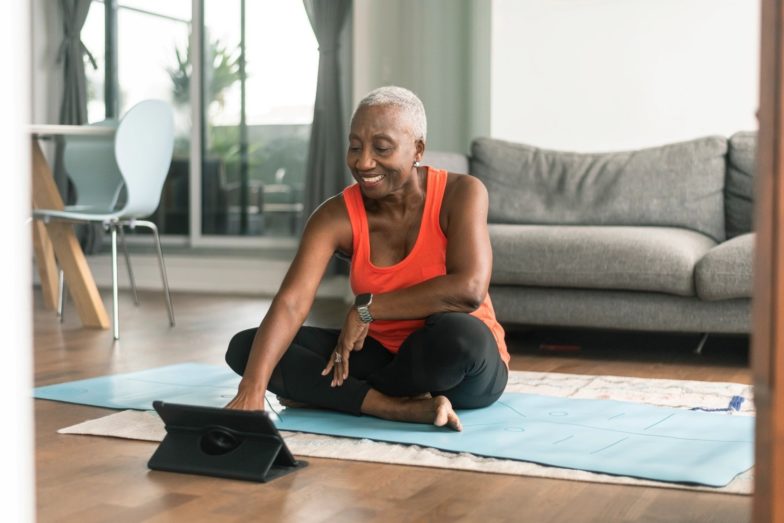Telehealth and rehabilitation

Pandemic accelerates technological solutions for remote patients
By Medline Newsroom Staff | September 21, 2021
When the country shut down in March 2020, physical therapists scrambled to meet the rehabilitation needs of their patients. In honor of National Rehabilitation Awareness Week, September 20-26, Medline sat down with Mike Cicero, out-patient physical therapist at Sutter Health’s Physical Therapy in Roseville, California, to talk about the necessity for telehealth, and how working at home and other pandemic-related habits are impacting overall musculoskeletal health.
Mike works at Sutter Medical Foundation, part of the Sutter Health network, and has more than 20 years of experience as a physical therapist. He began dabbling in telehealth six months before the pandemic hit, but found he quickly had to accelerate its use as elective surgeries slowed down and more patients were unable to meet with him and his team in person due to COVID-19 restrictions.
Medline Newsroom: How has your approach to therapy and rehabilitation changed over the past 18 months?
Mike Cicero: When COVID-19 restrictions were implemented, we found we had limited access to patients. At the time, only two of us at the clinic were setup to provide telehealth services. We had one single camera on a wall that we shared. Otherwise, we would schedule patients one hour apart, practice physical distancing, and clean the facility before the next patient would arrive.
As the pandemic continued, we had to quickly pivot to telehealth for many of our patients. In fact, there are some patients I’ve seen during the past 18 months who I’ve evaluated, treated and discharged through video visits without ever meeting them in person. The cool thing is we’ve had success. The patients have had improvement in terms of their objective and subjective measures, and their satisfaction is high.
The decrease in elective surgeries freed up our time for education. We trained other therapists in our clinic about the technology and how to conduct a session utilizing telehealth. After testing several platforms, we landed on a platform solution that integrates with our electronic health record system.
By May 2020, approximately 50% of our clinic appointments were conducted via telehealth. Today, our 15 therapists each have their own digital tablet and offer telehealth for their patients.
Newsroom: What are some benefits you have experienced with the increase in telehealth?
Mike: One big benefit of telehealth is access to patients in their own environment. Suddenly, a light shined on the real world of our patients, opening a bigger picture to their work spaces and home gyms. We are able to see how they are doing their therapy in vivo and make corrections. Without telehealth, we would have no idea that their at-home exercises were not being done correctly.
Telehealth also provides better office efficiencies. If there is a last-minute cancellation, we’re more likely to be able to schedule a telehealth visit than to have a patient drive from their home to the office for a last-minute appointment. This instant access to patients allows us to maintain a full schedule, and provide comprehensive care to more patients in our community.
Newsroom: How about the challenges?
Mike: The biggest challenge to telehealth is patients having proper access. Appropriate network connectivity is paramount to providing a seamless telehealth experience.
Another pitfall is that we can’t get our hands on our patients. We can’t assess their muscles, assess their wounds per se, and we can’t see how their joints move because we can’t physically get our hands on them.
That is why the ideal environment is to evaluate a patient in person first, and then perform video visits intermittently to check their home status and how they are doing their exercises, and to do periodic check-ins. This hybrid model would be a better utilization of service, and allow our clinics to be open for additional patients to come in.
Newsroom: What advice do you have for other clinics considering more robust telehealth services?
Mike: There are a lot of resources and costs associated with launching telehealth services. Sutter’s rapid expansion of telehealth services in response to COVID-19 included equipment purchases and deployment, software, staff and clinician training, in addition to an expanded IT infrastructure and support. This was made possible through the resources within our integrated network.
If you don’t have the infrastructure, you probably are going to need someone to come in and help. If you already have some existing infrastructure, you may be able to source telehealth internally.
Newsroom: What are some concerns when it comes to work from home environments for your patients?
Mike: The biggest concern is work station ergonomics. They’ve got a desk that doesn’t match their body type, or they may be using a small screen to work. In addition, they may be sitting in a dining room chair instead of the ergonomic chair that they have at work.
Ironically, it seems people spend more time sitting in one position while in the comfort of their home than they would if they were at work where they frequently get up to speak with colleagues and move around. They tend to sit statically more often.
Because of these factors, we are seeing a lot of postural dysfunction and musculoskeletal injuries.
Newsroom: Are you seeing an impact on seniors as a result of decreased community activity?
Mike: Absolutely. Seniors often relied on errands and community activities for their steps and physical activity. Today, that is limited, either because of fear or a perceived lack of safety in going out. As a result, seniors have deconditioned and are less physically fit.
Newsroom: Any final thoughts on telehealth?
Mike: In the grand scheme of things if someone is going to ask me if the fast track of telehealth was beneficial, I’d say absolutely, yes. By and large the patient feedback has been overwhelmingly positive. We were able to ramp up quickly to provide critical access to our patients and communities.
As a result, we became a kind of outlet for our patients, not just providing physical therapy services and what we do on a normal basis, but also giving them contact to the outside world when everyone was feeling like they were stuck at home, alone. That feels good.
Learn more about Medline’s therapy and rehabilitation solutions.
Medline Newsroom Staff
Medline Newsroom Staff
Medline's newsroom staff researches and reports on the latest news and trends in healthcare.

